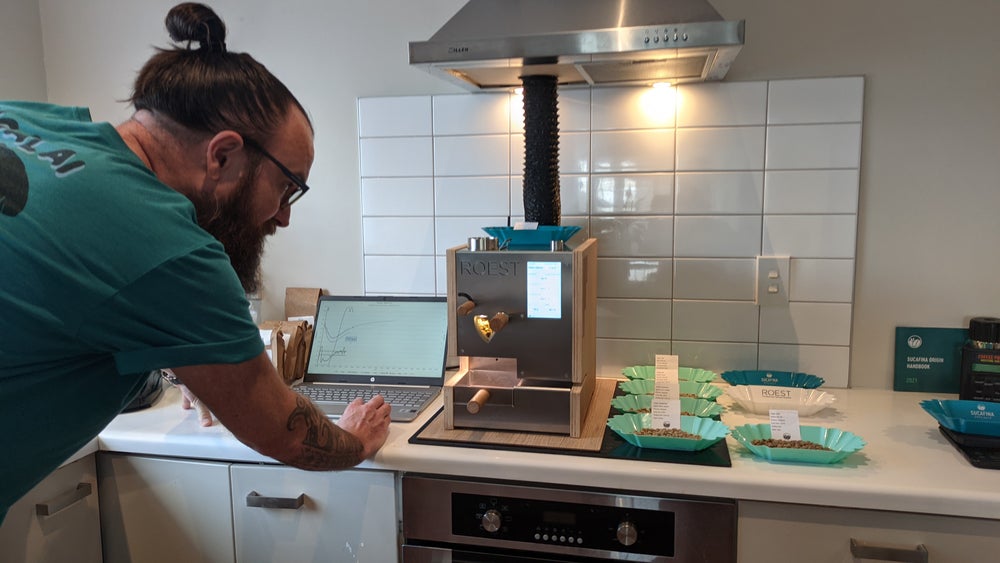From the Lab
Monday, September 27, 2021
Roasting (and Blending) For Espresso
Espresso is brewed differently than any other coffee and requires its own roasting method. I have 12+ years of experience roasting in Australia and New Zealand and am here to help you navigate the unique world of roasting for espresso.

Espresso Roast Basics
On the extraction level, the espresso process involves grinding beans much more finely and extracting flavor under high pressure. This forces much more oil and dissolved solids into the cup. For that reason, the development time ratio (the balance of drying, Maillard browning and development time) needs to be just right.
When compared with a lighter filter roast, this ratio of drying, Maillard and development will need to be a larger percentage of the roast in order to achieve a balanced cup. With a lighter filter roast, we’re highlighting more floral, acidic, fruity and delicate notes. These can still present very well when served as espresso, but can also result in a sour, astringent or underdeveloped flavor when not handled correctly. This is in part due to the decreased caramelization of sugars and subsequent pronounced acidity in filter roasting. While a lighter filter style roast is more versatile and can be served both as espresso and filter, serving an espresso roast as a filter brewing method will generally result in more undesirably bitter, roasty, dark flavors.
Crafting a Brief
The goal of roasting for espresso is to develop a profile with an optimal balance of sweetness, body, development and flavor, that expresses well when served as an espresso. So, while opinions vary widely when it comes to roasting principles, roasting for espresso is generally tailored specifically to suit high pressure extraction. In comparison to filter roasts, this generally requires an increased development time ratio.
In my experience, roasting for espresso is the culmination of many factors, but it typically starts with an initial project brief. Before we do any blending or roasting, we need to determine the desired outcome of this project. Will this be a house blend, seasonal blend or single origin? Then, we look at bean and origin selection, with the focus of what each component will bring to the blend. We’ll also have to consider seasonality and availability. Once we get there, we circle back to the origin brief: do my components match my brief? Pricing is also an important factor. What is my target selling price and what is the right green cost for this to be a viable project?
Once our brief is set, we’re ready to move onto the exciting stage of actual development and roasting.
Bean Selection
For the purpose of this article we’ll begin by talking about the process of developing a seasonal espresso blend. The key defining factor will be based on what season this blend represents and the associated flavors that represent that chosen season. For example, it’s winter here in New Zealand and plum, chocolate, spice, berry and maple would be a good starting point for a winter blend.
To achieve this, I would look at a selection of big, fruity Ethiopian Naturals and a Brazil Natural to bring a good chocolatey body with balanced sweetness. These 2 components may work very well together for your winter blend, or you may choose to add a third or even a fourth component. For example, you may add a washed Honduras or a wet hulled Indonesian to bring a spice component into the mix.
Whichever way you go, just remember to keep in mind the initial brief and don’t overcomplicate things. I find that 99% of the time you will be able to reach the desired outcome with 2 to 3 components in a blend. When you find yourself looking at 4, 5 or more components I think you really need to ask yourself: “what is each component bringing? And is each really necessary?”
Component Development
The next stage of development is to roast and taste each component separately with the aim of finding the roasting “sweet spot” for each. This is the point of optimum roast development that will express the best qualities of each component.
The sweet spot is when you achieve the perfect balance of sweetness, body, acidity and mouthfeel. Remember to keep the project brief outlines in mind. When dealing with single origins, once you have found this sweet spot, your mission is complete!
When tasting each component, it is important to do so via the desired brewing method e.g. as an espresso, because this is ultimately what you are developing this blend for. I would be looking to identify and eliminate any undesirable aspects like sourness, lack of body, lack of sweetness, bitterness or roasty/burnt notes due to either over- or under-development.
Now that we've covered the basics of crafting a brief, selecting green coffee and developing each component, we're ready to dive into blending and roasting for espresso. Check back next week for the second installment of this guide for roasting and blending for espresso!
ABOUT THE AUTHOR
Joseph Oosten, Trader with Sucafina Specialty New Zealand, has 12+ years of experience roasting in Australia and New Zealand. He started roasting in 2001 and has also operated his own cafe and served as a business consultant in the sector.